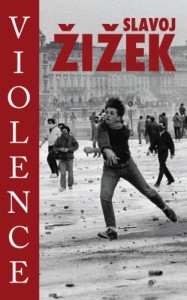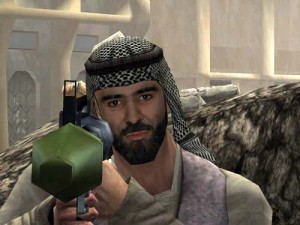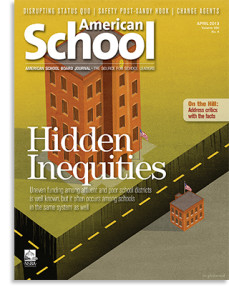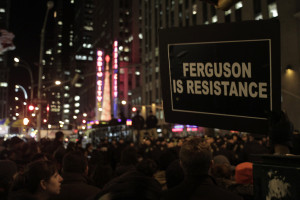Lesson Objectives:
- define violence
- delineate subjective, objective and systemic violence and describe their relationship
- evaluate the ethic of non-violence using theoretical approaches of leading scholars
Violence is a salient aspect of the human experience. It has played a critical role in shaping human history, and it remains a key part of contemporary human relations. Violence occurs in many forms; between individuals, one individual and a group, and/or between groups. Violence is so pervasive within human interactions that it is often taken for granted, and anthropologists studying violence often argue that the majority of scholarly and public attention is focused on the outcomes of violence (death, injury, suffering, trauma, etc.) rather than violence as a social phenomenon.
 This lesson will focus on one theory of violence as it is presented by Slovenian philosopher and cultural theorist, Slavoj Zizek, who calls to question the moral assessment of violence as a subjective perspective of being either ‘right’ or ‘wrong’. In his book, Violence (2008), Zizek draws on Marxist structural theory and Lacanian psychoanalysis to challenge others to conceptualize and analyze violence as a phenomenon rather than presume a moral condemnation of it. Like most of Zizek’s work, his theory of violence has ignited a significant amount of controversy because he takes a relativist approach to a highly sensitive and emotionally charged subject. The tendency to take an emotional approach to violence is the key point of Zizek’s thesis. He demands that we remove ourselves from the emotional lens that shapes our perspective. While critics argue that Zizek’s philosophy does little more than provoke argument and falls short of providing usable answers or solutions, others rebut that Zizek’s work compels people to produce their own solutions by forcing them to think first and then react.
This lesson will focus on one theory of violence as it is presented by Slovenian philosopher and cultural theorist, Slavoj Zizek, who calls to question the moral assessment of violence as a subjective perspective of being either ‘right’ or ‘wrong’. In his book, Violence (2008), Zizek draws on Marxist structural theory and Lacanian psychoanalysis to challenge others to conceptualize and analyze violence as a phenomenon rather than presume a moral condemnation of it. Like most of Zizek’s work, his theory of violence has ignited a significant amount of controversy because he takes a relativist approach to a highly sensitive and emotionally charged subject. The tendency to take an emotional approach to violence is the key point of Zizek’s thesis. He demands that we remove ourselves from the emotional lens that shapes our perspective. While critics argue that Zizek’s philosophy does little more than provoke argument and falls short of providing usable answers or solutions, others rebut that Zizek’s work compels people to produce their own solutions by forcing them to think first and then react.
Constructing Violence
Zizek begins his framework by arguing that any approach to violence must begin as a conceptual one, which avoids exaggerated empathy with victims:
‘My underlying premise is there is something inherently mystifying in a direct confrontation with it: the overpowering horror of violent acts and empathy with the victims inexorably function as a lure, which prevents us from thinking. A dispassionate conceptual development of the typology of violence must by definition ignore its traumatic impact. ‘ (p. 3)
He argues that the analyst must divorce themself from the empathic tendency (the very tendency identified as an evolutionary advantage in the video ‘Empathic Civilization’ by Jeremy Rifkin in the ‘Culture’ segment) which fixes on the outcome of violence rather than the phenomena of violence. Once we detach ourselves from the moral and emotional assessment, according to Zizek, we can redirect our attention to violence and see it in all of its forms. Zizek proposes three distinct, yet interconnected, forms of violence; subjective, objective and systemic which is commonly referred to as the ‘SOS’ framework.
Subjective Violence
Subjective violence is the form of violence that is immediately evident and visible because it results in bodily harm. This includes assault and killing, as well as the casualty outcomes of terror and war. It is the type of violence that is the most commonsensical because it is performed by an identifiable agent and the outcome(s) of the violence are easily identifiable. Because of this, subjective violence is often conceptualized as the defining dimension, or the only form, of violence. Yet, Zizek points out that objective violence and systemic violence are not only more pervasive than subjective violence, the two additional forms can also contribute to subjective violence.
Objective Violence
 Objective violence is largely characterized as symbolic violence. It is embedded in language, representation, and other symbolic systems of meaning. Hate speech and the various hierarchies inscribed in our language use, such as gender and race terms, are examples of objective violence that is embedded in daily language. Objective violence is less recognized, if it is recognized at all, because it is part of daily discourse and interactions. Although Zizek does not employ Bourdieu’s theoretical framework, we can come to understand objective violence as a form that exists within a person’s doxa and is expressed in action through habitus. Bourdieu refers to this as ‘symbolic violence.’ While objective violence is symbolic, it can inform subjective violence by underlying the circumstances in which subjective violence occurs. For example, gendered language that assigns women lower status (epithets such as ‘bitch’ or ‘slut’) can underlie domestic violence and abuse of women. Similarly, hate speech such as racial slurs and homophobic remarks form ideas and systems of meaning that are expressed through hate crimes. Patterns of representation, such as Othering discussed in the second module, creates a social distance between groups and can facilitate violence between the groups. For example, digital representations of peoples and cultures of the Middle East and North Africa in popular video games portrays very diverse and peaceful populations as threatening and violent. These representations, such as the image created by Kuma Games above, can be used to justify violence toward Arab and Islamic people living in the US and abroad. In most cases, however, people and society easily recognize the subjective outcomes of symbolic violence and fail to identify the symbolic systems of meaning that produce it.
Objective violence is largely characterized as symbolic violence. It is embedded in language, representation, and other symbolic systems of meaning. Hate speech and the various hierarchies inscribed in our language use, such as gender and race terms, are examples of objective violence that is embedded in daily language. Objective violence is less recognized, if it is recognized at all, because it is part of daily discourse and interactions. Although Zizek does not employ Bourdieu’s theoretical framework, we can come to understand objective violence as a form that exists within a person’s doxa and is expressed in action through habitus. Bourdieu refers to this as ‘symbolic violence.’ While objective violence is symbolic, it can inform subjective violence by underlying the circumstances in which subjective violence occurs. For example, gendered language that assigns women lower status (epithets such as ‘bitch’ or ‘slut’) can underlie domestic violence and abuse of women. Similarly, hate speech such as racial slurs and homophobic remarks form ideas and systems of meaning that are expressed through hate crimes. Patterns of representation, such as Othering discussed in the second module, creates a social distance between groups and can facilitate violence between the groups. For example, digital representations of peoples and cultures of the Middle East and North Africa in popular video games portrays very diverse and peaceful populations as threatening and violent. These representations, such as the image created by Kuma Games above, can be used to justify violence toward Arab and Islamic people living in the US and abroad. In most cases, however, people and society easily recognize the subjective outcomes of symbolic violence and fail to identify the symbolic systems of meaning that produce it.
Systemic Violence
 Systemic violence results from the hierarchical organization of social and economic systems in societies, what Zizek refers to as the “often catastrophic consequences of the functioning of our economic and political systems”. Systemic violence is inherent to the organization of an institution or society. This includes exclusion, alienation, hegemony and subtle forms of coercion that sustain relations of dominance and exploitation in a society. Systemic violence helps to reproduce and sustain the status quo and its social structures. Zizek evokes Marxist structuralist theory to represent capitalism as one of the most important forms of systemic violence within contemporary societies because it is an economic system that relies on the uneven distribution of resources (privatization of property) and the exploitation of the labor of those (workers) who are deprived access to resources that are controlled by capitalists. Systemic violence contributes to the manifestation of easily identifiable subjective violence, such as death and injury caused by labor riots or unsafe working conditions (ie mining industry). Yet, systemic violence also contributes to more subtle, and often unrecognized, forms of subjective violence on the bodies of workers such as exposure to contamination and nutritional deprivation due to low wages. For example, if low wages (systemic violence) prevent workers from accessing nutritious food, they may develop chronic diet-related illnesses (subjective violence) and/or die (subjective violence) due to the inability to afford health care and treatment.
Systemic violence results from the hierarchical organization of social and economic systems in societies, what Zizek refers to as the “often catastrophic consequences of the functioning of our economic and political systems”. Systemic violence is inherent to the organization of an institution or society. This includes exclusion, alienation, hegemony and subtle forms of coercion that sustain relations of dominance and exploitation in a society. Systemic violence helps to reproduce and sustain the status quo and its social structures. Zizek evokes Marxist structuralist theory to represent capitalism as one of the most important forms of systemic violence within contemporary societies because it is an economic system that relies on the uneven distribution of resources (privatization of property) and the exploitation of the labor of those (workers) who are deprived access to resources that are controlled by capitalists. Systemic violence contributes to the manifestation of easily identifiable subjective violence, such as death and injury caused by labor riots or unsafe working conditions (ie mining industry). Yet, systemic violence also contributes to more subtle, and often unrecognized, forms of subjective violence on the bodies of workers such as exposure to contamination and nutritional deprivation due to low wages. For example, if low wages (systemic violence) prevent workers from accessing nutritious food, they may develop chronic diet-related illnesses (subjective violence) and/or die (subjective violence) due to the inability to afford health care and treatment.
Objective violence can also inform systemic violence by legitimizing systemic violence in the minds of people in a society. For instance, referring to people as ‘illegals’ carries the idea that people who do not possess certain documents are not entitled to the same protections and rights as those who do. Therefore, people who do not possess certain documents are often exposed to more hazardous working conditions, lower wages, and dangerous circumstances that incur subjective violence on their bodies.
Interventions
Zizek argues that it is only after parsing out the different forms of violence, and their interactions, that we can come to understand violence in all of its forms and engage in interventions. What then, is one to do with the agent (individual actor) who engages in systemic, objective or subjective violence? This brings us to one of the more controversial points within Zizek’s philosophical approach because he aims to challenge the assumption that the agent is the embodiment of the act. He relies on Jacque Lacan’s notion of ‘paradoxical reversal’ to the actors of violence by drawing out that actors who engage in acts of violence oftentimes engage in acts of humanity as well.
“One thing that never ceases to surprise the native ethical consciousness is how the very same people who commit terrible acts of violence towards their enemies can display warm humanity and gentle care for the members of their own group.” (p.40)
Zizek draws the uncomfortable parallel between Bill Gates and a Nazi officer. A Nazi spent his days at work exterminating people and then went home to play with his young son and/or help his neighbor fix their house. Zizek points out that Bill Gates is a capitalist who created the ‘Gates Foundation’ for humanitarian action while simultaneously profiting immensely from the mass exploitation of child workers in deplorable conditions overseas. Within Zizek’s model, Gate’s participation in systemic violence (exploitation of child workers) produces a considerable amount of subjective violence on the bodies of thousands of poor children each year. Yet, the subjective outcomes are masked by the Gates Foundation.
‘Charity,’ Zizek writes, is the humanitarian mask hiding the face of economic exploitation,’ He proclaims that the worst slave-owner was familiar and gentle to the people they enslaved because the humanity merely served to prolong the suffering and injustice of enslavement by making it appear tolerable. According to Zizek, charity allows systemic violence to persist. If society abolishes systemic violence, Zizek writes, there would be no need for charity.
Zizek also laments that violence, most notably in its subjective form, is often mediated as a characterization of social life in peripheral areas such as the media representation of suicide bombings in the Middle East or ruthless dictatorships in Africa. He calls for critical self-reflection as means to identify the, often unrecognizable, ways that people in core nations participate in violence and are affected by violence within their own social contexts.
‘The self-reflexive sensitivity to one’s own limitation can only emerge against the background of the notions of autonomy and rationality promoted by liberalism. One can, of course, argue that, in a way, the Western situation is even worse because in it oppression itself is obliterated and masked as free choice … Our freedoms of choice effectively often functions as a mere formal gesture of consent to our own oppression and exploitation…when we compare a Third World woman, forced to undergo clitoridectomy or promised in marriage as a small child, with the First World woman ‘free to choose’ painful cosmetic surgery, the form of freedom matters – it opens up space for critical reflection’ (p.147-8).
Zizek brings an interesting complexity to the question of violence by going beyond the commonsensical moral tendency to reject it and challenging readers to address it as a system of complex social phenomena that is embedded within daily discourse and action. By deconstructing and reconstructing violence, the actors of violence, and the recipients of violence, we can call greater attention to how violence is produced, the role of violence in society, and the various effects of violence on the human experience.
For a more indepth analysis of Zizek’s ideology of violence, watch the lecture posted in the video below.
Readings: Select ONE
Luther King, M. ‘Chaos or Community: Where do we go from here?’ or ‘The Power of Non-Violent Action’ in Lemert
Gelderloos, Peter. ‘How Nonviolence Protects The State (see video )
Churchill, Ward.’ Pacifism as Pathology‘
Ghandi, M. ‘Satyagraha‘ or ‘Non-violent Force: A Spiritual Delimma’ in Lemert
Malcolm X: By Any Means Necessary (speech) and ‘Debate’ with MLK (interview)
For Discussion:
 Within activist communities, resistance movements, and revolutionary circles, the definition of violence and the use of violence has become a contentious and divisive issue. When, if ever, is it necessary to use violence to overcome oppression? And what type of violence is acceptable or unacceptable? Use one of the readings or videos to engage in a debate about the use of violence in resistance or revolutionary movements. Argue as if you are the author of that reading. This is important – you are NOT expressing your own ideas or opinions, you are simply arguing on behalf of the author (selecting Gelderloos or Churchill does not imply that ‘you’ are advocating for the use of violence.) The purpose of this debate is to come to understand the different ways that violence is conceptualized and approached by different peoples and cultures.
Within activist communities, resistance movements, and revolutionary circles, the definition of violence and the use of violence has become a contentious and divisive issue. When, if ever, is it necessary to use violence to overcome oppression? And what type of violence is acceptable or unacceptable? Use one of the readings or videos to engage in a debate about the use of violence in resistance or revolutionary movements. Argue as if you are the author of that reading. This is important – you are NOT expressing your own ideas or opinions, you are simply arguing on behalf of the author (selecting Gelderloos or Churchill does not imply that ‘you’ are advocating for the use of violence.) The purpose of this debate is to come to understand the different ways that violence is conceptualized and approached by different peoples and cultures.
